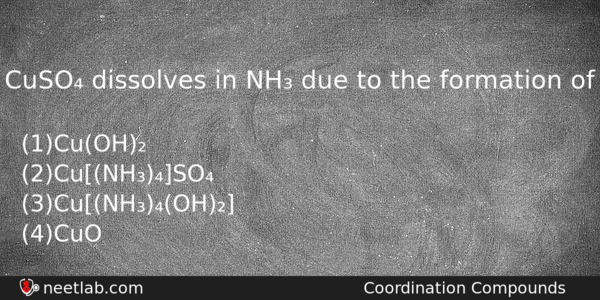| ⇦ | 
| ⇨ |
CuSO₄ dissolves in NH₃ due to the formation of
Options
(a) Cu(OH)₂
(b) Cu[(NH₃)₄]SO₄
(c) Cu[(NH₃)₄(OH)₂]
(d) CuO
Correct Answer:
Cu[(NH₃)₄(OH)₂]
Explanation:
NH₃+ H₂O→ NH₄OH
CuSO₄ + NH₄OH → Cu(OH)₂ + (NH₄)₂ SO₄ / Cu(OH)₂ + 2NH₄OH + (NH₄)₂ SO₄ → [Cu (NH₂)₄] SO₄ + 4 H₂O ( Tetrammine cupric sulphate
The complex is called as Schotzer’s reagent which is used for dissolving cellulose in the manufacture of artificial silk.
Related Questions: - A physician wishes to prepare a buffer solution at pH = 3.85
- In the case of alkali metals, the covalent character decreases in the order
- In a given atom no two electrons can have the same values for all
- The elements with atomic number 9,17,35,53,85 are called
- Which of the following does not react with I₂ and NaOH
Topics: Coordination Compounds
(87)
Subject: Chemistry
(2512)
Important MCQs Based on Medical Entrance Examinations To Improve Your NEET Score
- A physician wishes to prepare a buffer solution at pH = 3.85
- In the case of alkali metals, the covalent character decreases in the order
- In a given atom no two electrons can have the same values for all
- The elements with atomic number 9,17,35,53,85 are called
- Which of the following does not react with I₂ and NaOH
Topics: Coordination Compounds (87)
Subject: Chemistry (2512)
Important MCQs Based on Medical Entrance Examinations To Improve Your NEET Score
18000+ students are using NEETLab to improve their score. What about you?
Solve Previous Year MCQs, Mock Tests, Topicwise Practice Tests, Identify Weak Topics, Formula Flash cards and much more is available in NEETLab Android App to improve your NEET score.
Share this page with your friends

Leave a Reply